
We spend a lot of time talking about caring for your lawn, but your ornamental trees and shrubs also need special attention to stay healthy and strong. Here are the most important steps you can take to care for them through the fall and prepare them for the transition to winter.
Prune
Winter weather conditions can cause dying or dead branches and limbs to fall unexpectedly. It’s best to prevent problems by proactively inspecting your trees and removing potential hazards.
Rake
Remove fallen leaves from beneath ornamental trees and shrubs with a leaf blower or rake. Leaves can form a barrier that prevents air, water and nutrients from reaching roots. Leaf cover can give harmful fungus a place to hunker down for the winter where it waits for the first rainfall of spring to wake up and spread to your beloved trees and shrubs.
Fertilize
Trees in our yards don’t have access to the wide variety of nutrients they would get from decomposing organic material on a forest floor. Therefore, it’s extremely important that we supply them with extra nutrients to last through the winter. On a related note…
Mulch
In addition to the beauty it adds to ornamental beds, mulch insulates roots, aids in moisture retention and protects soil from washing away in heavy rain. Plus, the mulch itself feeds your ornamental plants as it naturally breaks down and releases its nutrients.
For best results, your mulch island should extend out to the drip line of the tree (the area covered by the tree’s canopy), because that’s roughly how far the roots extend underground. If that’s not possible, extend the circle as far you can—at least two to three feet.
Mulch should never touch the base of a tree, because retaining moisture in contact with bark can cause it to rot, creating entry points for insects and fungi. The goal is avoiding the root flare, so a distance between eight inches and one foot should be safe. The layer should be two to three inches deep.
Water
As with your grass, it’s best to water deeply and thoroughly a couple of times per week rather than lightly and frequently. In this context, though, the depth reached by tree roots requires a slightly different approach.
You don’t have to worry as much about evaporation when the weather is cooler, so your watering session can span most of a day. Place a hose within the drip line, set the water to a very low trickle, and leave it in place for two to three hours. Do this twice more, moving the hose about one-third of the way around the circle each time. One of these rounds each week may be sufficient, but you may find you need a second soaking.
At Simply Organic, we believe in harnessing the power of nature to maintain your lawn and your ornamental trees and shrubs at their best. If you have questions about these recommendations or any other aspect of our service, please contact us at 678.498.6446 or click the “Ask a Question” link on our home page.

